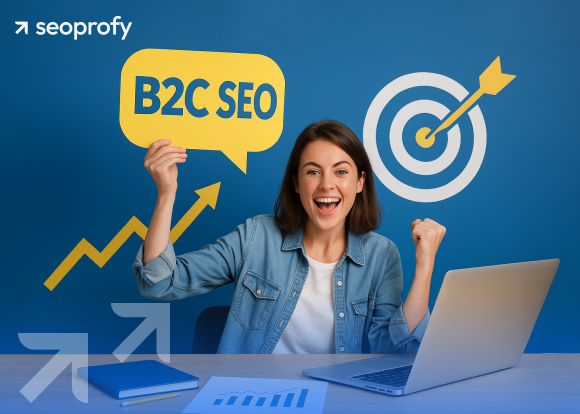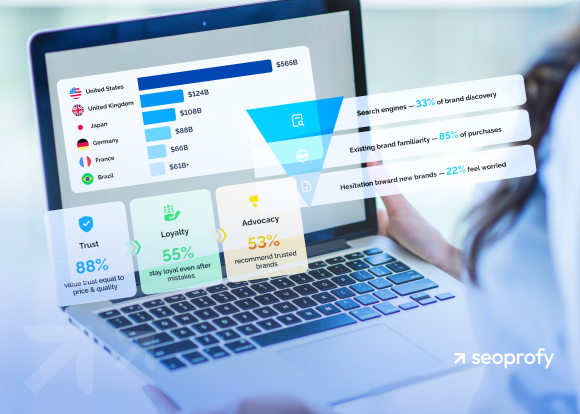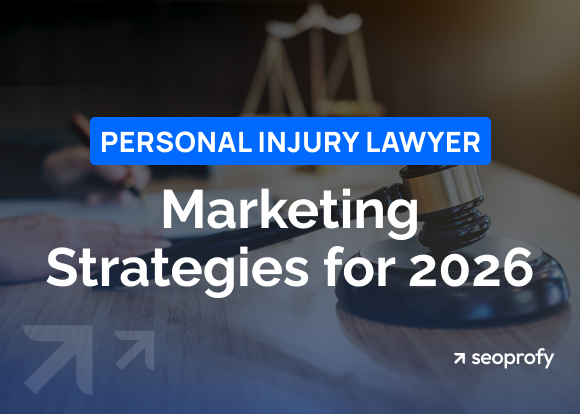Running a business has never been easy, especially considering the great competition in all industries. So, how can you stand out from the crowd when it comes to reaching your target audience and converting them into loyal customers? An efficient B2C SEO strategy is just what you need!
There is a significant difference between managing a business-to-business and a business-to-consumer company. It’s relevant not only for the implementation of marketing techniques but also for search engine optimization. Our B2C SEO guide will help you improve your website to attract new visitors and grow your revenue.
- B2C businesses focus on individual customers who tend to make instant purchases.
- SEO should be among your main priorities, as only 3.45% of all pages receive traffic from Google.
- The efficient combination of CRO and SEO can skyrocket your organic traffic and sales.
- 50% of people who search for brick-and-mortar businesses online actually visit a discovered place.
SEO in B2C Marketing
B2C marketing focuses on connecting directly with the target audience by appealing to their immediate needs and preferences. Unlike B2B strategies, it emphasizes emotional triggers, fast decision-making, and broad market reach. To stand out, B2C websites must embrace search engine optimization (SEO) as a core digital strategy.
With only 3.45% of all pages receiving traffic from Google, achieving visibility through SEO is crucial. Effective tactics like keyword research, on-page optimization, and quality content help attract organic traffic and improve rankings. These efforts can be maximized by working with a competent SEO company, regardless of the size of the business, from a small local store to a major eCommerce retailer.
For example, organic traffic accounts for 23.6% of all eCommerce orders, which underlines its role in driving conversions. Beyond visibility, SEO enhances user experience, builds trust, and increases brand recognition. Overall, businesses can increase client retention and achieve long-term growth in cutthroat digital markets by making strategic SEO investments.
Difference Between B2C and B2B SEO
Many people believe there is no difference between the B2B SEO techniques and those used for B2C companies. While some techniques may be implemented in both cases, there are still a lot of unique factors that should be considered while optimizing a business-to-customer website.
| Aspect | B2C | B2B |
| Target audience | Individual consumers | Businesses |
| Sales cycle length | The B2C buyer journey is often emotionally driven and may take up to a few days or minutes. | A complex and long B2B sale process takes from 1 to 18 months. |
| Keyword strategy | The main focus is to target relevant keywords that resonate with individual customers, including competitive long-tail keywords and emotionally driven phrases. | B2B keywords are typically specific, high-value terms related to industry topics. While they are often more specialized than B2C keywords, competition is still significant, especially in high-demand or niche markets. |
| Content marketing | The content for B2C sales is often informational but, at the same time, creative and transactional. Its main goal is to inspire a customer to make an instant purchase. | B2B companies often generate content that offers solutions to prospective clients, establishes authority, and builds lasting business relationships. |
| SEO metrics and goals | The B2C SEO aims to attract organic traffic, drive immediate sales, and boost the brand’s visibility. Plus, it improves social engagement and overall user experience. The main B2C KPIs include:
|
The main goal of a B2B SEO campaign is to improve the brand’s authority, establish long-term partnerships, and generate quality leads, converting them into loyal customers. The main metrics here are:
|
Essential B2C SEO Steps for Business Growth and Visibility
By implementing the best SEO practices, you can ensure a stable flow of clients and establish a strong brand regardless of your company’s type and size. The steps described below will help you develop a detailed business growth strategy. Taking them one at a time, you’ll conquer the top of the search engine results pages and leave your competitors far behind.
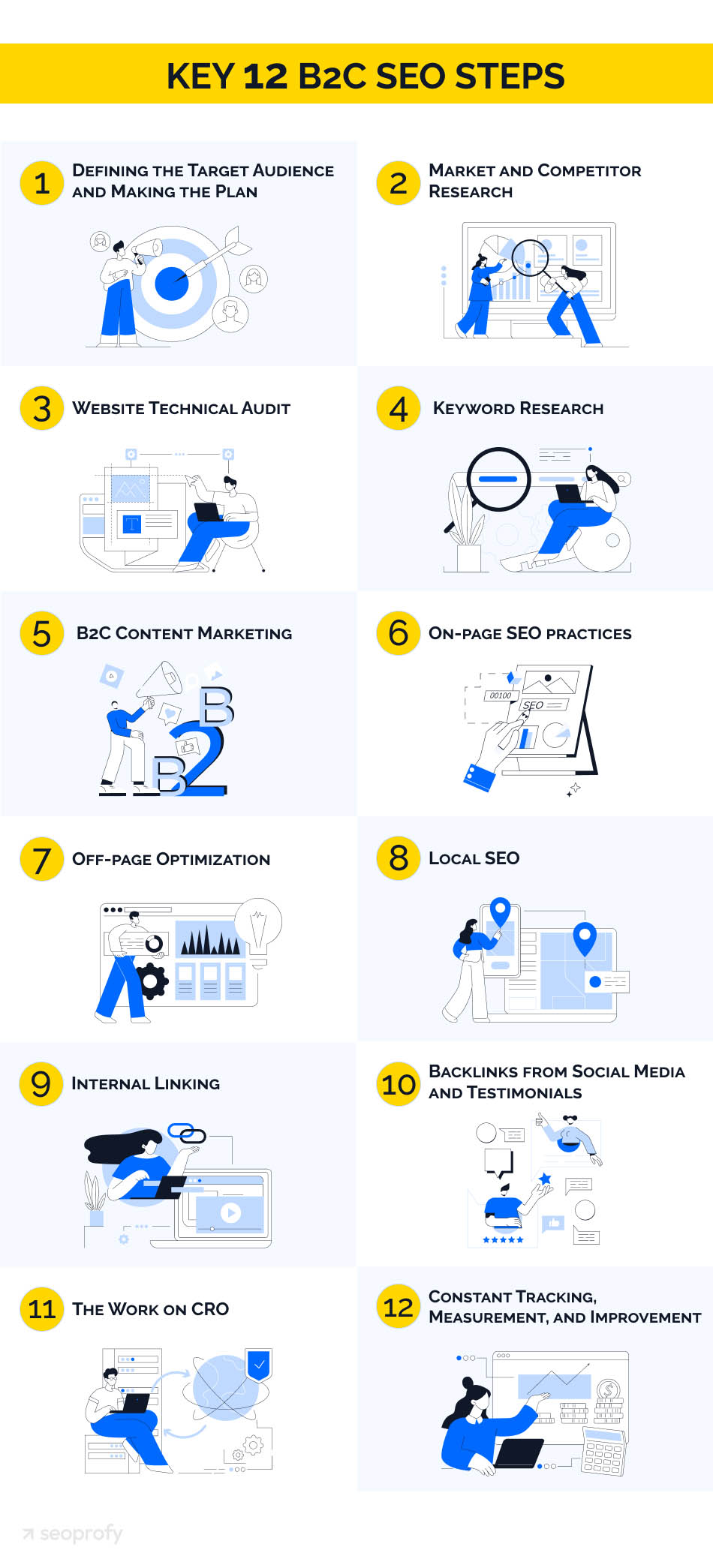
1. Defining the Target Audience and Making the Plan
First, you have to set an SEO goal and define your target audience. Without knowing your prospective clients’ behavior, main interests, and pain points, you won’t be able to create content that will catch their attention and inspire them to purchase.
You should create a detailed portrait of your ideal customer, also known as a “buyer persona.” Try to highlight their preferences, problems, and behaviors. Depending on your B2C business, you may have several buyer personas. It’ll be a good idea to brainstorm to identify as many of them as possible.
In addition, when creating a portrait of your buyer persona, ensure that this is not just a client who needs or wants your products or services. They should also be financially able to purchase it. Further, analyze the existing data to update your buyer persona’s portrait. You should pay attention to the following details:
- Customer demographics: Collect and analyze the information of your existing clients. Focus on the main demographic factors, including age, gender, income, education, residential area, and marital status. By processing this data, you can identify common behavioral patterns of your target audience.
- Customer satisfaction: Identify the high-converting consumers who have recently made purchases or interacted with your brand. You should surely focus on creating content to reach more clients of this buyer persona type. At the same time, pay attention to unsatisfied customers to discover the areas of improvement for your B2C company. You may also spot the main problems preventing people from purchasing during different stages of their journey through the sales funnel.
- Competitors’ customers: Finally, examine the clients successfully targeted by your major business opponents. Thus, you can expand your target audience and discover new opportunities for your brand’s growth. You can discover the competitor’s buyer personas by analyzing their social media accounts, target keywords, customer reviews, etc.
Using the information about your target audience and considering your business goals, you can start building an SEO strategy. Select the techniques that will help you reach the most prospective clients and focus on their efficient implementation. Additionally, careful planning is essential to accurately determining SEO pricing.
2. Market and Competitor Research
Once you know your potential clients, it’s time to pay attention to your key competitors. By analyzing the marketing techniques and online presence of your business opponents, you can discover efficient B2C SEO strategies and get a lot of useful insights related to:
- Keywords: You need to identify the high-performing keywords used by your competitors. It’s important to prepare a list of these words so you can organically weave them into your content to increase your pages’ search rankings. If you can’t choose among the best SEO tools, the most appropriate for this task, we recommend you opt for Ahrefs. Use its Keyword Gap to add your main competitors and reveal the keywords that contribute the most to the organic growth of their websites:

- Inbound links: It’s necessary to discover the reputable online sources that provide your competitors with valuable backlinks. After that, you also need to try asking them for references to enhance your authority. Luckily, you can save a lot of time with the help of Ahrefs Quick Batch Analysis and its comprehensive overview of your competitors’ backlink profiles. Simply add the URLs of your main competitors, and the platform will provide you with the total number of links leading to their pages to allow you to review each of them:
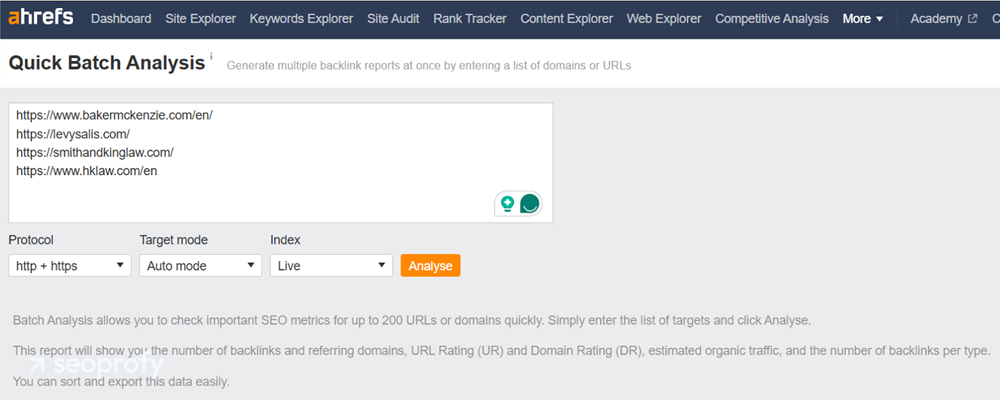
- Content: You need to identify the topics that are absent from your blog but are covered by your competitors. Using Semrush’s Content Gap tool, you can analyze other websites to discover content ideas that will help you fill the gaps on your own site. For example, here, it discovered the keywords that three websites don’t rank for because they miss the topics related to them. At the same time, we can see that the last site (the purple one) has already covered them to reach a broader audience:

- Technical SEO: This is one of the most efficient B2C SEO practices, but if you want to get the most out of it, you should also analyze your competitors’ websites. It’s important to check their structures, load times, and mobile optimization peculiarities and compare them with your site’s technical performance. If you notice it needs improvements, implement learned insights ASAP. For example, in the screenshot below, you can see how the tool identifies critical issues like soft 404 pages, HTTP security flaws, internal URLs blocked by robots.txt, and excessive page title lengths. These insights help you understand not only your own site’s technical condition but also what’s standard (or problematic) in your niche.
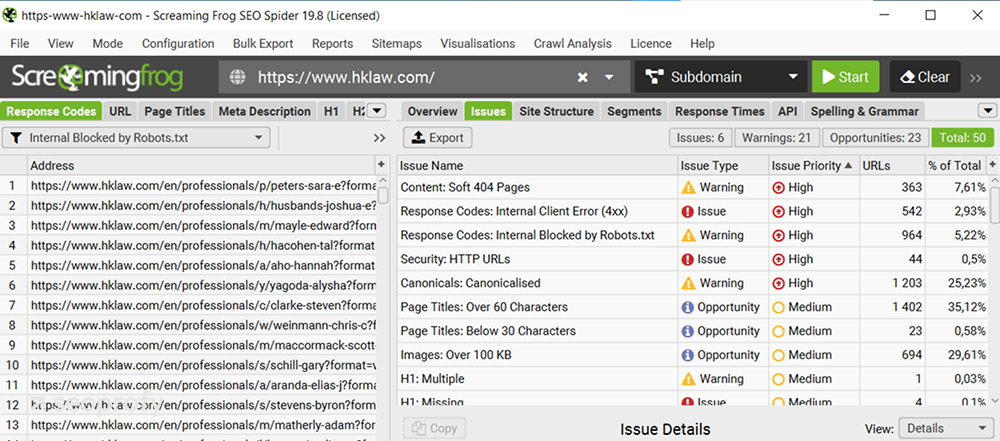
- Social media: Finally, you can opt for Social Mention and BuzzSumo to analyze your competitors’ social media activity to estimate their influence on their target audience. Discover and use their most efficient practices to create your loyal community on popular platforms.
Beyond identifying tactical opportunities, competitor analysis also helps shape a broader strategic view. Here’s how. Analyzing your competitors allows you to benchmark performance and define the key metrics to measure SEO results of your digital marketing strategy. Check the important indicators like monthly organic traffic flow, average CTR, conversions, etc.
Also, during the SEO campaign setup, you need to pay attention to the main market trends. It’s essential to keep an eye on them and implement them to keep pace with the constantly changing preferences of your audience.
3. Website Technical Audit
Not only is it important to check the technical background of your competitors, but also essential to focus on this part of your website. Consider that the success of your entire B2C SEO campaign depends on this step, as this site’s “internal kitchen” directly influences the user experience. Due to the comprehensive analysis of your website, you’ll be able to find the tiniest bugs and issues that contribute to the growth of the bounce rate.
Plus, a technical audit can help you optimize your site for smartphones, which is extremely important for search engines. Consider that 62.54% of global online traffic comes from mobile devices. So, if you want to increase your conversion rate, you undoubtedly need to optimize your website for this category of users.
It’s essential to run a mobile-friendly test using Lighthouse by Google to check your website’s performance on various portable devices. The tool estimates various metrics and discovers the ones that need improvement. It’s strongly recommended to immediately pay attention to red issues as they affect your technical background the most:
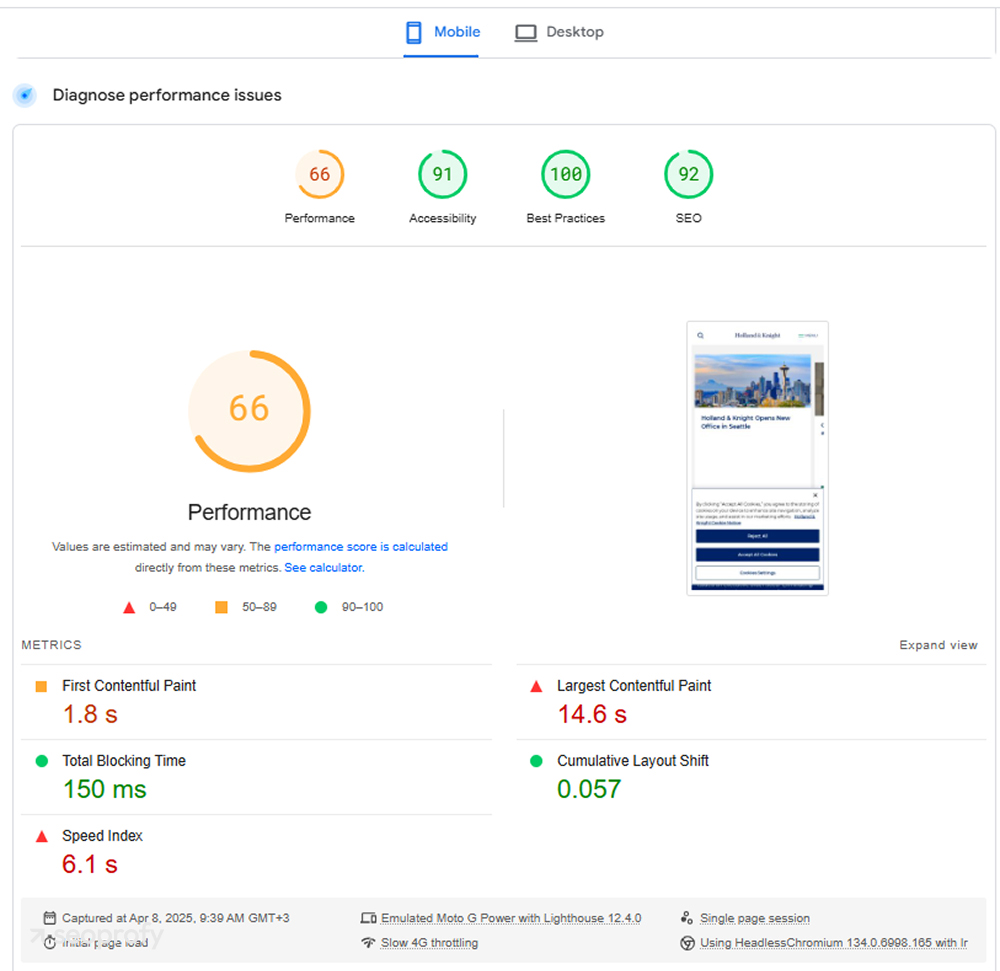
If you aren’t sure you can conduct a comprehensive technical SEO analysis on your own, our team will be glad to lend a helping hand! After our one-time audit service, you’ll get a detailed report highlighting the tiniest issues that prevent you from reaching the top rankings. Also, SeoProfy will provide tips to help you solve the issues you discovered.
4. Keyword Research
Keyword research is one of the cornerstones of any efficient B2C SEO approach. However, it’s important not only to analyze your competitors’ keywords. You also need to learn how to identify the terms and phrases your target audience uses when looking for the services and products related to your niche. Plus, you need to efficiently and organically implement them into your content. It’ll improve your keyword rankings and drive more organic traffic, leading to higher conversion rates.
You can start your research by following this simple algorithm:
- Analyze seed keywords: Brainstorm the terms related to your B2C business and assemble them in a list. For instance, if you run a law firm, you can start with keywords like “law firm”, “legal services”, etc.
- Divide the keywords among the types of your buyer personas: Define how search terms differ for every type of your potential clients, considering their interests and needs.
After that, use keyword research tools for B2C SEO to define the most popular and valuable terms in your list. For instance, you can opt for Ahrefs to estimate the value of each phrase. Let’s look at the high-frequency keyword “family lawyers near me.”
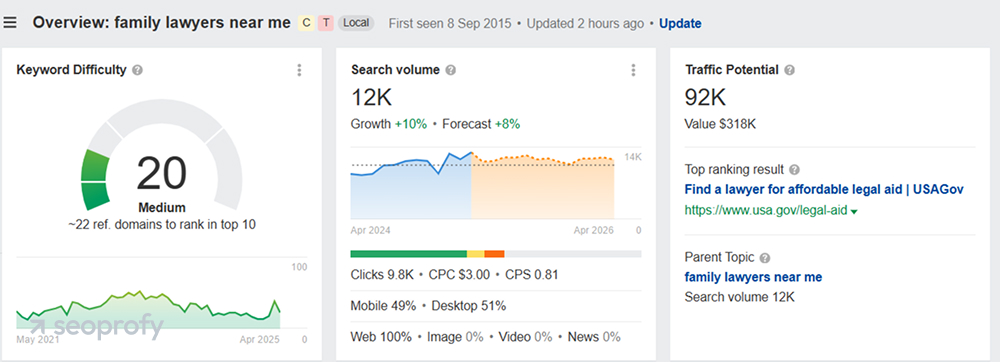
During this stage, it’s recommended to focus on the following metrics:
- Keyword difficulty (KD): Estimates the competition level for each keyword. If this metric is higher than 54, it’s difficult to rank for it.
- Search volume (SV): Shows the number of monthly searches for a certain term. The higher this metric, the more popular a keyword is. However, the competition is also fiercer.
- Cost per click (CPC): Displays the price an advertiser pays for every click on an ad containing a keyword. If this metric is low, it means that not many companies bid for Google ads on this term.
SeoProfy is here to help you grow your business. Our custom B2C SEO campaigns will boost your success with significant benefits:
- Clear workflow and efficient SEO services
- Unique data-driven insights
- Conversion optimization
- Transparent pricing

5. B2C Content Marketing
Content is king, and if you want to conquer your niche and improve your site’s B2C SEO performance, you need to attract customers with interesting, helpful, and unique blog posts. First, you’ll need to develop a detailed plan that includes the topics that solve your prospective customers’ issues. When you forge interesting information and provide valuable tips, you significantly increase your brand’s authority in the eyes of your clients.
Besides, one of our B2C SEO case studies proves that creating useful content for your users is extremely important, especially after the release of Google’s Helpful Content Update. Now, search engines inspire the site’s owners to provide their visitors with meaningful and readable information.
After reviewing the client’s blog posts, our team increased their uniqueness by over 90%, improved their structure, and optimized their length. In combination with other SEO techniques, we helped our client recover from Google’s update and continue getting organic traffic.

Regardless of your niche, it’ll be a good idea to experiment with different types of content until you discover the ones that provide your website with the best results. As a rule, B2C businesses opt for the following ideas:
- Blog posts
- Videos
- Infographics
- Podcasts
- Testimonials
- Case studies
6. On-page SEO practices
All your SEO efforts and exciting content will be useless if you don’t optimize the on-page elements of your website. This process involves improving different behind-the-scenes aspects to improve your pages’ findability and performance on search engines. As a rule, during B2C SEO campaigns, you can improve the on-page elements, following the time-tested practices, including:
- Improvement of metadata: Ensure your title tags and meta descriptions contain main keywords and a reasonable number of characters to make them more visible to search engine algorithms. You can use a dedicated tool to check them.

- URL optimization: Use hyphens for word separation, lowercase letters, keywords, and natural language to create short and descriptive URLs.
- Image compression: Reducing the size of the visual elements can greatly increase the page’s load speed, which is essential for a positive customer experience and high ranking on SERPs. As a rule, the size of all images on a page shouldn’t exceed 500 KB. Also, don’t forget to add alt text so search engines can better understand their relevance to the users’ search intent.
- Structure enhancement: All pages and blog posts on your website should be divided into sections, ensuring their clear structure. It will significantly simplify your customer journey through your site.
- Schema markup integration: Using the encoding method JSON-LD, you need to incorporate markup into the pages’ code to add vital elements like price information, photos, availability, star ratings, etc.
7. Off-page Optimization
Although you know how to analyze your competitors’ backlinks, you should also learn how to search for unique link building opportunities. Luckily, there are several efficient SEO techniques that can strengthen your backlink profile to make your B2C business more authoritative in the “eyes” of search engines.
But, first of all, consider that you should never buy links. Due to regular updates, Google’s algorithms can now estimate the quality of the backlinks in your profile. If they spot that you’ve used black-hat SEO practices, such as purchasing low-quality inbound links, they may lower your site’s rankings or even ban it. Thus, a backlink with a high domain rating (DR) from a website related to your niche will be more useful than 1,000 irrelevant inbound links.
During your B2C SEO campaign, you should analyze your backlink profile, using tools like Ahrefs. This amazing platform allows you to review all links to your website and check whether there are any broken ones. Also, Ahrefs can help you estimate whether all references are obtained from trustworthy online sources by revealing their domain ratings (DR) and traffic.
For instance, here we can see that the site of Quinn Emanuel law company has 1,084 links in its profile. Nonetheless, considering that the DR of a reputable website should be at least 40, we can see that there are backlinks that need removal:
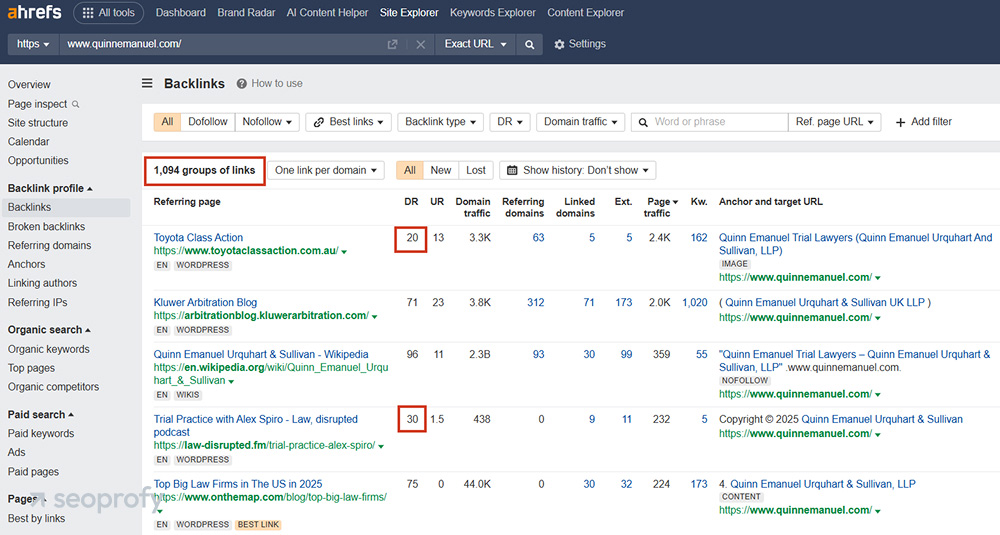
Consider that providing the audience with valuable content is the best way to obtain as many high-quality references as possible. You can achieve this goal by posting statistics, unique reports, and diagrams with top-quality visuals.
Also, there are other ways to ensure the stable growth of your backlink profile in terms of your B2C SEO. For instance, you can obtain new hyperlinks by opting for the following link building methods:
- Guest blogging: You can contribute interesting content to authoritative sites within your industry and include a backlink to your website within the content or in your author bio.
- Digital PR: This practice involves getting coverage in popular media outlets. You need to provide journalists with your expert commentary, data-driven industry insights, or any other valuable content to get a reference.
- HARO: You can respond to journalists’ queries on special platforms to earn backlinks. By providing your expert opinion, you’ll get features in articles, eventually improving your site’s SEO performance and online authority. Although the HARO platform isn’t available anymore, you can still opt for Qwoted, Featured, Terkel, etc.
8. Local SEO
If you run a local brick-and-mortar business, your B2C SEO strategy should also include improving your influence in the target region. Interestingly, 50% of people who conduct a local search on their smartphone visit a discovered place. Thus, you need to be the first to get noticed by these users.
You can ensure your business growth by implementing the following local SEO techniques:
- Google Business Profile optimization: It’s crucial to have an up-to-date Google Business Profile that contains as much information as possible. Also, always inspire your clients to leave positive reviews.
- Use social media: Create a social media profile for your target region to reach and engage the local community.
- Local directories: You can find local citations featuring the business from your niche. Ensure you’re listed on them to get valuable backlinks and attract the attention of potential customers.
9. Internal Linking
Internal links act like passageways, significantly simplifying the user’s navigation through your website. They guide the visitors to relevant content, increasing their engagement and converting them into loyal clients. For example, weaving internal links to your product pages into your popular blog posts can inspire a user to get acquainted with your offers and make a purchase.
In addition, these links are important for a successful B2C search engine optimization as they help search engine bots to crawl your website and index its pages. They also help create a content hierarchy and identify topic clusters.
10. Backlinks from Social Media and Testimonials
Social media marketing also offers high-quality backlinks to accelerate your B2C SEO efforts. They boost your authoritativeness, which is one of the key parts of Google’s E-E-A-T (Experience, Expertise, Authoritativeness, and Trustworthiness) guidelines. And when it comes to developing your B2C brand, social media plays a prominent role as it allows your business to attract a large audience. Further, almost any platform, such as Instagram or YouTube, provides the possibility to add a link to your website in your bio.
B2C SEO strategies often involve the development of attractive social media profiles with the help of the following techniques:
- Tutorials: Opt for quick tutorial videos on Instagram, Facebook, or TikTok, as well as long “how-to” guides on YouTube, to review your products in action.
- Giveaways: Many small businesses still offer their audiences the opportunity to win prizes for activity on their social media channels. This is a great way to attract new customers and draw attention to your brand.
- User-generated content: Finally, you can post your customers’ testimonials and reviews to build trust and drive new clients toward your website. According to BrightLocal’s research, 33% of modern customers believe an average business needs at least 20 reviews to justify its rating.
11. The Work on CRO
Conversion rate optimization (CRO) is critical in complementing your B2C SEO campaign efforts by converting the traffic you attract into loyal customers. This technique involves the improvement of your site’s design and content to coincide with the implemented search engine optimization adjustments, particularly:
- Placement of user-generated reviews and social proof on the website’s pages
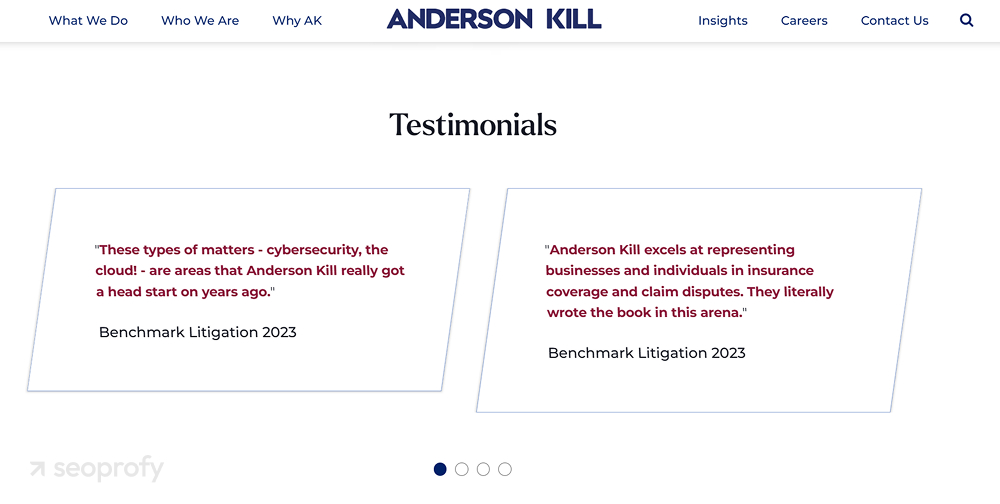
- Elimination of unnecessary actions in the customer journey
- Simplification of the contact form to increase the number of submissions
- Regular usability testing with the help of tools like Crazy Egg
CRO is great for increasing SEO ROI and strengthening your business. Don’t forget to analyze your users’ behavior after adjusting the site’s design to determine what works best for your audience.
12. Constant Tracking, Measurement, and Improvement
Finally, implementing a B2C SEO strategy isn’t a swift sprint — it’s an endless marathon. Your website needs constant management and performance analysis to stay on top of search results. It’s essential to monitor the latest Google updates and industry trends to adapt your strategy accordingly.
Using tools like Ahrefs, Semrush, and Google Search Console, you can thoroughly plan your next steps and keep growing your B2C business. Plus, don’t forget to update your content regularly to keep all your blog posts up to date.
Boost Your Sales with Effective B2C SEO
Our B2C SEO guide offers game-changing solutions to take your business to the next level. They’ll help you stand out from numerous competitors, grow an astonishing brand, and make your revenue skyrocket.
On the other hand, it may be difficult to implement all the mentioned SEO tips by yourself. Luckily, you can always rely on SeoProfy and our innovative approach to search engine optimization.

